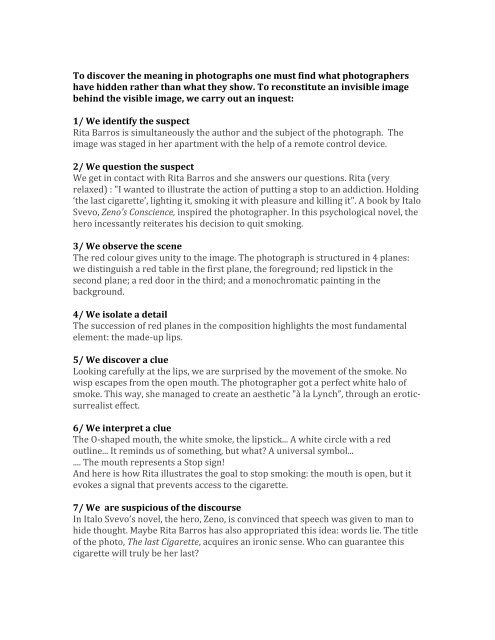erotic-surrealist
last cigarette-text_Francesca_Serra.pdf - rita barros
last cigarette-text_Francesca_Serra.pdf - rita barros
- No tags were found...
Create successful ePaper yourself
Turn your PDF publications into a flip-book with our unique Google optimized e-Paper software.
To discover the meaning in photographs one must find what photographers <br />
have hidden rather than what they show. To reconstitute an invisible image <br />
behind the visible image, we carry out an inquest: <br />
1/ We identify the suspect <br />
Rita Barros is simultaneously the author and the subject of the photograph. The <br />
image was staged in her apartment with the help of a remote control device. <br />
2/ We question the suspect <br />
We get in contact with Rita Barros and she answers our questions. Rita (very <br />
relaxed) : "I wanted to illustrate the action of putting a stop to an addiction. Holding <br />
‘the last cigarette’, lighting it, smoking it with pleasure and killing it". A book by Italo <br />
Svevo, Zeno's Conscience, inspired the photographer. In this psychological novel, the <br />
hero incessantly reiterates his decision to quit smoking. <br />
3/ We observe the scene <br />
The red colour gives unity to the image. The photograph is structured in 4 planes: <br />
we distinguish a red table in the first plane, the foreground; red lipstick in the <br />
second plane; a red door in the third; and a monochromatic painting in the <br />
background. <br />
4/ We isolate a detail <br />
The succession of red planes in the composition highlights the most fundamental <br />
element: the made-‐up lips. <br />
5/ We discover a clue <br />
Looking carefully at the lips, we are surprised by the movement of the smoke. No <br />
wisp escapes from the open mouth. The photographer got a perfect white halo of <br />
smoke. This way, she managed to create an aesthetic "à la Lynch”, through an <strong>erotic</strong>-<strong>surrealist</strong><br />
effect. <br />
6/ We interpret a clue <br />
The O-‐shaped mouth, the white smoke, the lipstick... A white circle with a red <br />
outline... It reminds us of something, but what? A universal symbol... <br />
.... The mouth represents a Stop sign! <br />
And here is how Rita illustrates the goal to stop smoking: the mouth is open, but it <br />
evokes a signal that prevents access to the cigarette. <br />
7/ We are suspicious of the discourse <br />
In Italo Svevo’s novel, the hero, Zeno, is convinced that speech was given to man to <br />
hide thought. Maybe Rita Barros has also appropriated this idea: words lie. The title <br />
of the photo, The last Cigarette, acquires an ironic sense. Who can guarantee this <br />
cigarette will truly be her last?
8/ We thwart Rita’s plan <br />
The cigarette is omnipresent: <br />
-‐ it is evoked in the title <br />
-‐ Rita Barros holds a cigarette <br />
-‐ a pack of Malboro Lights sits on the table. <br />
The photographer seems to wish to draw our attention to this object. But she insists <br />
too much to be honest. Like a slight-‐of-‐hand, her true intent is maybe to distract our <br />
attention. What if the cigarette was a trick? What if the subject of the photograph <br />
could be found elsewhere? <br />
9/ We elaborate on a hypothesis <br />
Let us imagine that this Stop sign does not prevent the entry of the cigarette, rather <br />
the exit of.... Of what? What breaks the barrier of the lips? <br />
The voice, the spoken word. <br />
Maybe Rita Barros is expressing a fear characteristic of artists: the inability to <br />
express themselves, to communicate. The colour white works as a counterpoint to <br />
the colour red. We are talking about the anguish of an author confronted with a <br />
white page on which he cannot write. In French “ une voix blanche” (a white voice) <br />
means that we are under emotional stress: in this case white is used to express the <br />
absence of words. <br />
10/ We finish the inquest <br />
In Italo Svevo’s novel, Zeno is going through psychoanalysis. Well, words are at the <br />
centre of the analytical device, since the patient, to get rid of his ailment, must be <br />
able to name it. The latent <strong>erotic</strong>ism of the photograph reveals a frustration. We <br />
witness a photographic refutation of Munch’s cry. Rita Barros has transformed it <br />
into a mute cry. <br />
Francesca Serra <br />
“The Last Cigarette” <br />
Grazia.fr. <br />
(Translated from the French)


